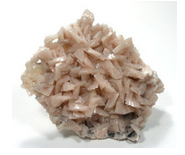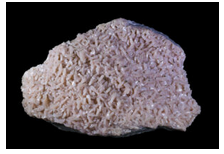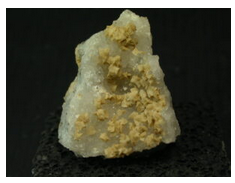14.7.2: Dolomite Group Minerals
- Page ID
- 18674
Dolomite CaMg(CO3)2
Origin of Name
Named after Déodat de Dolomieu (1750–1801), a French chemist and geologist.



Hand Specimen Identification
Dolomite is characterized by typical rhombohedral carbonate habit and cleavage. It effervesces slightly by reaction with cold dilute HCl when powdered, but not when solid.
The light pink/beige color of the reticulated dolomite in Figures 14.377 and 14.378 sometimes helps identify this mineral, but color is not a particularly reliable property and dolomite can be white or other colors. When white (Figure 14.379) it may be mistaken for calcite. When brown or tan, it may be mistaken for ankerite.
Physical Properties
| hardness | 3.5 to 4 |
| specific gravity | 2.85 |
| cleavage/fracture | perfect rhombohedral {101}/subconchoidal |
| luster/transparency | vitreous/transparent to translucent |
| color | usually a shade of pink, can be white, colorless, brown, black, green, or gray |
| streak | white |
Properties in Thin Section
Dolomite is similar to calcite in thin section, but has lower RI and two possible orientations of polysynthetic twins. Uniaxial (-), ω = 1.679, ε = 1.500, δ = 0.179.
Crystallography
Dolomite is hexagonal (rhombohedral), a = 4.84, c = 15.96, Z = 3; space group R3; point group 3.
Habit
Dolomite forms rhombohedral crystals, having the shape of cleavage fragments, often with curved faces. Less commonly they are prismatic or steep rhombohedra. Lamellar twinning is nearly always present but may be hard to see. Massive subhedral or anhedral dolomite, showing rhombohedral cleavage, is common.
Structure and Composition
Dolomite is isostructural with calcite, CaCO3, nordenskiöldine, CaSnB2O6, and with a number of other minerals (see calcite structure). Fe and Mn may substitute for Mg in substantial amounts. Co, Pb, Zn, Ce, or excess Ca may also be present.
Occurrence and Associations
Dolomite is a common mineral, found in massive carbonate sediments and in marbles, often with calcite. It also occurs in hydrothermal veins with fluorite, barite, other carbonates, and quartz, and as a secondary mineral or alteration product in limestone.
Related Minerals
Huntite, CaMg3(CO3)4, has quite similar properties. Dolomite forms solid solutions with ankerite (Ca-Fe carbonate), kutnohorite (Ca-Mn carbonate), minrecordite (Ca-Zn carbonate), and norsethite (Ba-Mg carbonate).
Ankerite CaFe(CO3)2
Origin of Name
Named after M. J. Anker (1772–1843), an Austrian mineralogist.

Hand Specimen Identification
Typical rhombohedral carbonate habit and cleavage, effervescence by cold dilute HCl when powdered, and yellow-brown to brown color usually identify ankerite. It is sometimes confused with calcite or dolomite, and less commonly with siderite. This photo shows crystals of ankerite on quartz.
Physical Properties
| hardness | 3.5 |
| specific gravity | 3.10 |
| cleavage/fracture | perfect rhombohedral {101}/subconchoidal |
| luster/transparency | vitreous/transparent to translucent |
| color | white, yellow-brown |
| streak | white |
Properties in Thin Section
Ankerite is similar to dolomite in thin section, but tends to be stained red or brown by iron oxidation. Uniaxial (-), ω = 1.750, ε = 1.548, δ = 0.202.
Crystallography
Ankerite is a trigonal mineral. a = 4.82, c = 16.14, Z = 3; space group R3; point group 3.
Habit
Rare crystals of ankerite are usually rhombs often with curved faces, or prisms. Lamellar twinning is nearly always present but may be hard to see. Granular ankerite is sometimes found. Massive subhedral to anhedral ankerite showing rhombohedral cleavage is most typical.
Structure and Composition
Ankerite is isostructural with calcite, dolomite, and many other minerals (see calcite structure). It may contain substantial Mg replacing Fe. Minor amounts of Mn, Co, Pb, Zn, Ce, or excess Ca may also be present.
Occurrence and Associations
Ankerite is most common in Precambrian iron formations. It is also found in veins and as replacements in limestones.


